How to Handle 14 Types of Rashes in Babies and Children
It's scary when your child's skin is suddenly red and itchy. Our guide will help you figure out the cause and the cure. The pictures aren't pretty, but you'll be glad you looked!
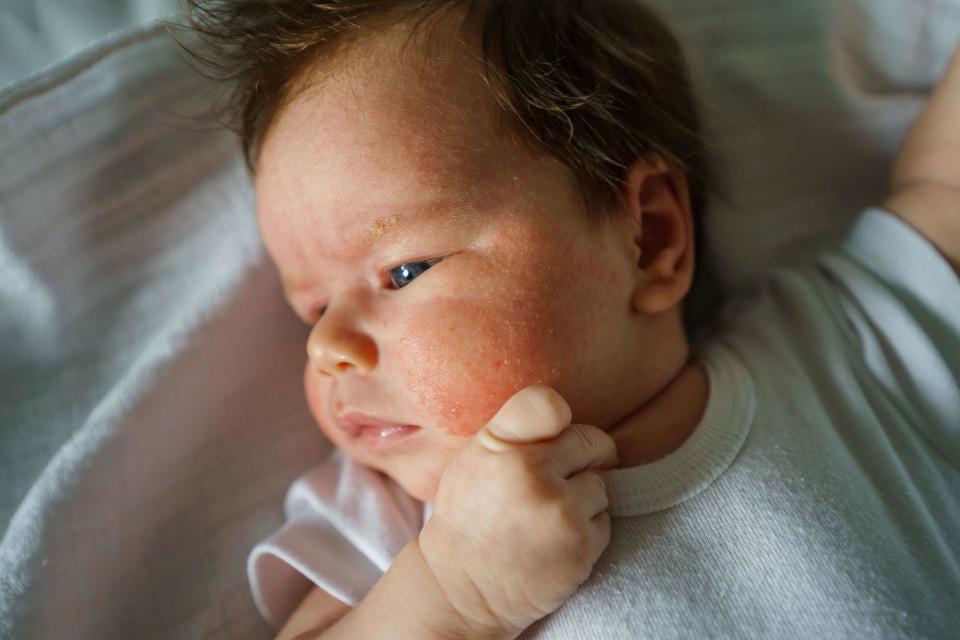
It can be scary when your child's skin is suddenly red, itchy, blistered, blotchy, or swollen. Rashes are relatively common in babies and children, and their causes can vary widely. Sometimes a rash indicates an allergic reaction, for example, while other times it points to a serious condition like measles.
This guide breaks down 14 possible causes of rashes in little ones, including the following:
Contact dermatitis
Atopic dermatitis (eczema)
Fifth disease
Heat rash
Hand, foot, and mouth disease (HFMD)
Measles
Hives
Roseola
Poison ivy, oak, or sumac
Molluscum
Chickenpox
Impetigo
Ringworm
Swimmer's itch
This guide isn't extensive, and you should always contact a health care provider for any concerning skin symptoms, Still, our descriptions might help you figure out the cause and cure for several common kid rashes. The pictures aren't pretty, but you'll be glad you looked!
Contact Dermatitis
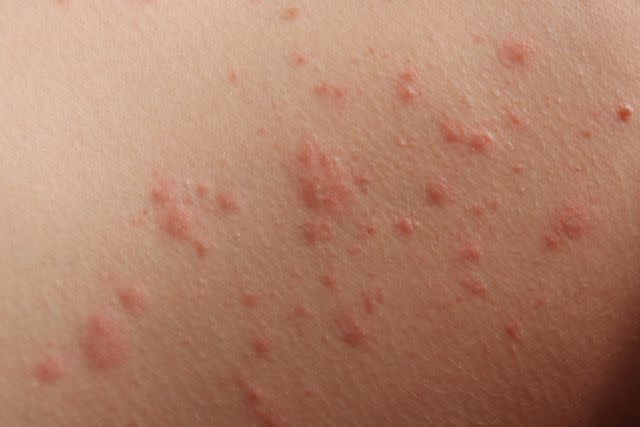
Getty Images / marie martin
Contact dermatitis looks like red bumps that can form weeping blisters or dry, cracked red patches. The rash shows up where the skin was exposed to an offending substance, appearing immediately or days later. Aside from the red irritation, symptoms include itching, swelling, tenderness, and bumps.
Cause: Common culprits of contact dermatitis include soap, detergent, lotion, perfume, cosmetics, jewelry, latex items, metals (especially nickel), chemicals, and poisonous plants. The rash appears in the places exposed to the irritant or allergen.
Treatment: Cool compresses can dry out the blisters and a topical or an oral corticosteroid and/or an antihistamine, such as Benadryl, helps with swelling and the itch. The rash can last up to several weeks and occasionally longer.
When to Seek Help: If the rash is not getting better or worsens after two or three days, or if your child seems very uncomfortable, consult with their health care provider. Should the rash not improve after a few days under a pediatrician's care, you may be referred to a dermatologist or an allergist.
Atopic Dermatitis (Eczema)
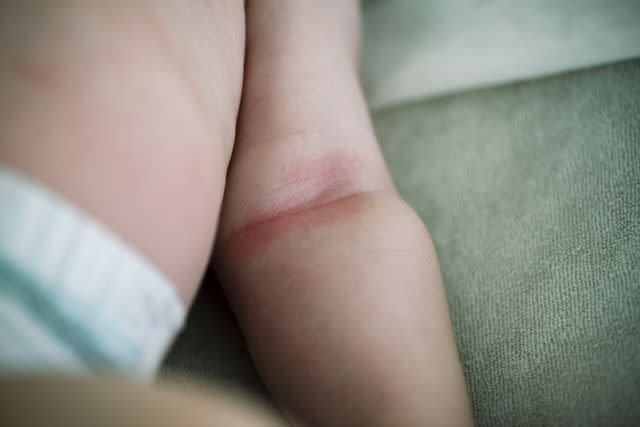
Getty Images / Emilija Manevska
Atopic dermatitis or eczema presents as dry reddish patches, small raised bumps, and/or thickened, cracked, or scaly skin. It often shows up on the face, arms, legs, and in the creases of the elbows or knees.
Cause: This rash is not contagious or caused by an illness. It's unknown exactly why some people develop eczema. However, environmental and genetic factors, stress, and immune system function are all at play.
Environmental triggers—such as exposure to dust mites, chemical irritants, climate conditions, hot showers, and food sensitivities—can bring on outbreaks or worsen the rash. It tends to run in families and some kids with eczema are missing a protein in the skin that prevents excessive dryness. About 10% to 20% of young kids develop it (often as babies); as they age, eczema can become less severe. Roughly half outgrow it.
Treatment: To treat eczema, keep skin well moisturized. Short lukewarm baths with minimal use of a fragrance-free cleanser will help keep skin moist, along with liberal use of a doctor-recommended lotion, such as Eucerin or Cetaphil. A topical corticosteroid can be applied daily to the affected areas. Continue moisturizer lotion use even after the rash subsides to prevent and reduce the severity of future outbreaks. Reducing exposure to any known triggers can help, too.
When to Seek Help: If you're not seeing improvement after a couple of weeks, contact your child's pediatrician. They may prescribe a stronger corticosteroid to get the rash under control. And if your doctor's recommendations aren't helping after another two weeks, they may suggest you visit a dermatologist or an allergist for long-term care.
Fifth Disease
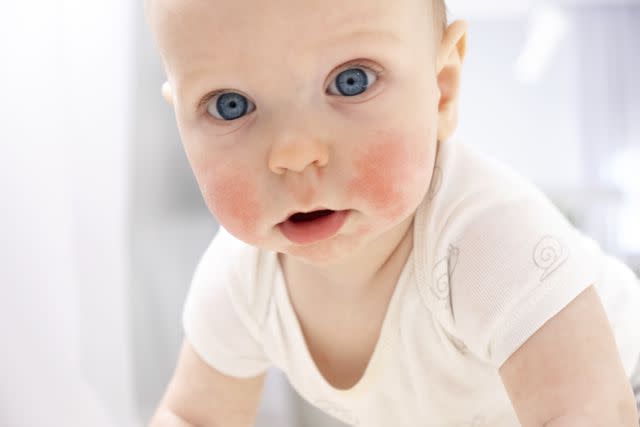
Getty Images / Nemer-T
Fifth disease is a bright-red rash that often resembles a slapped cheek or a sunburn and then spreads to the trunk, arms, and legs
Cause: According to the Centers for Disease Control and Prevention (CDC), fifth disease is characterized by fever, headache, cough, sore throat, and rash. This viral infection tends to target young school-age kids. It's transmitted through secretions from coughs and sneezes and is no longer contagious after the rash appears. So, kids with the rash can safely return to school or other public gatherings.
Treatment: This rash starts with a fever that you can treat with acetaminophen or ibuprofen. To treat itchiness, use a topical corticosteroid or an antihistamine such as Benadryl. Symptoms often clear up within two weeks.
When to Seek Help: If you're unsure of a diagnosis, or if the medications are not helping with the symptoms, contact your child's pediatrician.
Heat Rash
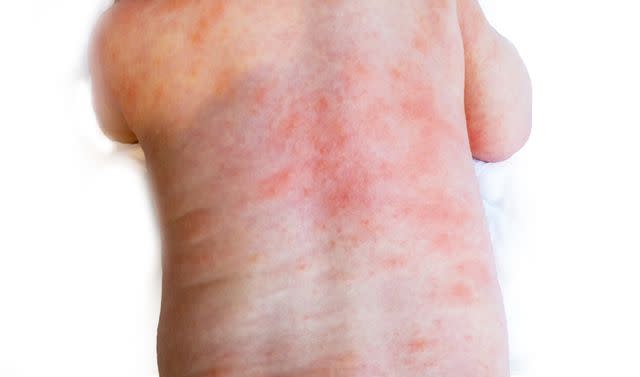
Getty Images / 1510924950
Heat rash in kids—which is also called miliaria, prickly heat, or sweat rash—is a faint red rash with tiny red bumps or clear blisters that are most common on the neck, forehead, and shoulders. It also tends to show up on warmer body parts, such as the trunk, groin, skin creases, and armpits, particularly if covered in tight or unbreathable fabrics.
Cause: A warm environment and an overdressed child are a recipe for heat rash. When your child is overheated, their sweat glands may get plugged, trapping perspiration under the skin. "Babies are prone to heat rashes because their small sweat glands clog easily," says Parents advisor Jennifer Shu, MD, a pediatrician at Children's Medical Group in Atlanta.
Treatment Keep your kid well-hydrated, cool, and dry to avoid or lessen the severity of this rash. In hot weather, be mindful of staying out in the heat. Seek shade and don't skimp on the AC. Dress your child in loose-fitting, lightweight clothes that allow the skin to breathe. Symptoms typically subside within a few days. Soothe their rash by letting their skin air out and applying cool compresses and cornstarch.
When to Seek Help: Contact your child's pediatrician if there is no improvement after three or four days.
Hand, Foot, and Mouth Disease (HFMD)
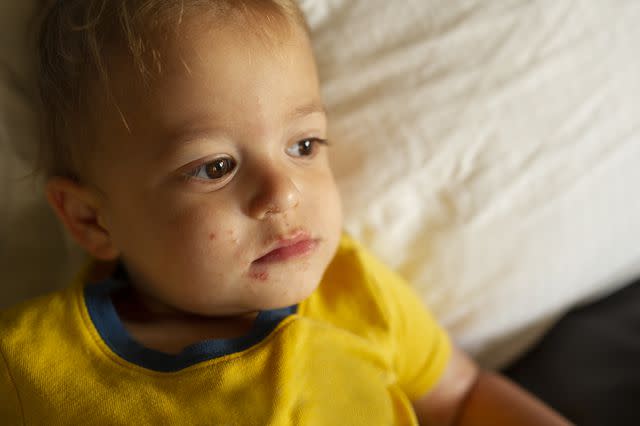
Getty Images / Jill Lehmann Photography
This rash is characterized by red, often painful, blister-like bumps on the tongue, gums, and inner cheeks. Your child might also have a red rash—perhaps with blisters—on the palms, soles, and buttocks.
Cause: The Coxsackievirus causes hand, foot, and mouth disease (HFMD), which is common among kids aged 5 and under. It's spread through contact with contaminated droplets from nose and throat discharge, fecal matter, and fluid from blisters, for example.
Treatment: The rash goes away on its own and symptoms last about a week. HFMD usually comes with a fever and a sore throat, so give acetaminophen or, for babies over 6 months, ibuprofen. Because the mouth sores can sting, avoid salty, hot, or spicy foods. Cool liquids (or popsicles) can offer relief.
When to Seek Help: Contact their doctor if your child has a high fever, is in severe pain, exhibits signs of dehydration, or if over-the-counter medications aren't helping.
Measles
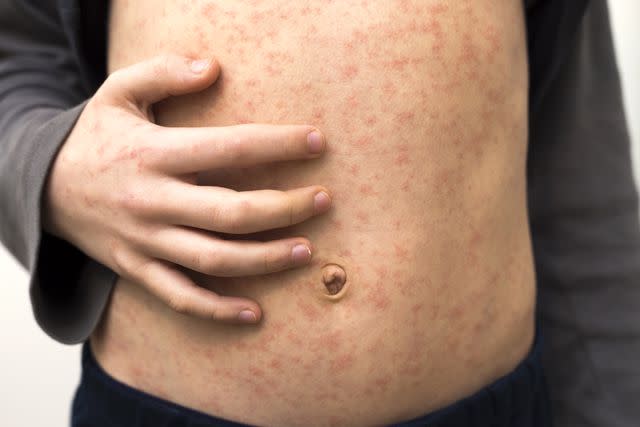
Measles looks like flat red spots that cover the whole body; they appear about three to five days after other symptoms (high fever, cough, runny nose, and red, watery eyes). Sometimes, there are raised bumps on top of the spots, or the spots may link together.
Cause: Measles is a highly contagious virus that lives in the nose and throat. It's spread via coughing and sneezing. The virus is most contagious about four days before and four days after a rash appears. According to the CDC, about one in five people who get measles are hospitalized. This illness can be particularly serious for children under 5.
Treatment: Getting an MMR (measles, mumps, and rubella) vaccine is the best way to protect your child (and community). The CDC recommends kids get two doses; the first dose is given between 12 and 15 months, and the second dose is between 4 and 6 years. Babies between 6 and 11 months who are traveling outside the U.S. should also one dose before leaving. Parents and grandparents who have not been vaccinated can still get the vaccine; those who have been vaccinated can get a booster shot.
If your child gets measles, rest is the best medicine. You'll also need to quarantine to avoid spreading the disease to others. Camomile lotion, lukewarm baths, and using a humidifier can help soothe symptoms. Use ibuprofen or acetaminophen to treat the fever that usually accompanies this illness.
When to Seek Help: If you or your child show signs of measles or are unvaccinated and have been around someone who has measles, call your child's pediatrician right away. Even if you've have been exposed to the virus, a vaccine can still be given up to 72 hours later, which will prevent or reduce the severity of the illness.
Hives
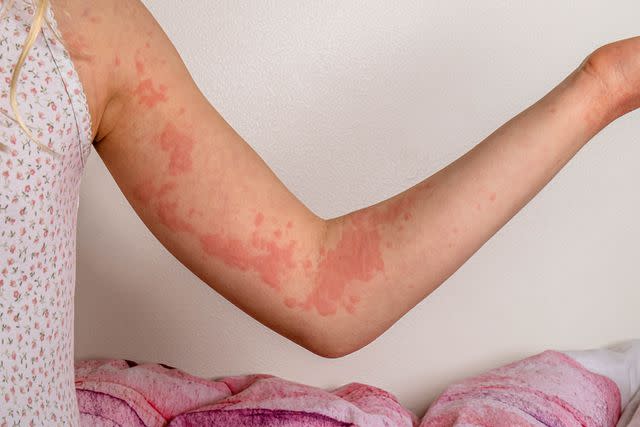
Eik Scott / Getty Images
Hives (also called urticaria) are small raised bumps or large welts, red or pink in color. They can stay in one place on the body or may spread all over. Hives are often accompanied by swelling of the hands or feet in children.
Causes: Hives in young kids are often caused by a skin reaction to something. The actual trigger can be tricky to pinpoint, but possible irritants include plants, food, pet salvia, or pollens, as well as bug bites or stings. Note that hives can also be triggered by viral infections, especially if they're widespread. Hives might appear without a known cause. Contact their doctor to help determine the trigger if you're unsure.
Treatment: If hives are caused by an allergy, wash the substance off the skin, and apply ice if it itches. An antihistamine and a topical corticosteroid can help during extremely itchy periods, along with cool baths and cool compresses. Consider Benadryl as well. A typical bout can last up to three or four days. In rare cases, hives can linger for several weeks. Once identified, avoid the allergen to treat hives.
When to Seek Help: Call a medical provider if hives last more than a few days. Children with breathing problems due to swelling should be seen by a doctor immediately. If the rash is still there after several weeks, your child's pediatrician may recommend testing for allergies and other conditions.
Roseola
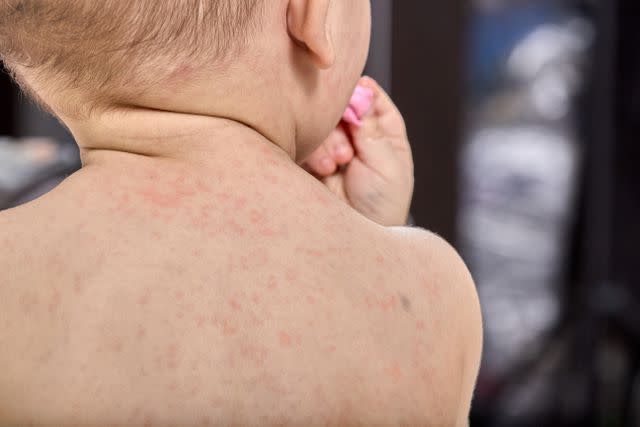
Getty Images / Aleksandr Pykhteev
Also called sixth disease, roseola looks like a pinkish-red rash on the trunk that might spread to the neck, arms, legs, and face. It might be raised or flat. Roseola isn't itchy or uncomfortable for your child.
Causes: Roseola comes from a virus and occurs mostly in children 6 months to 1 year of age. The first symptoms include sudden high fever, eye redness, runny nose, sore throat, and irritability—and a few days later, your child will develop the rash. As with many viral infections, kids can catch it from another child's cough or sneeze.
Treatment: Roseola rash usually doesn't itch, so there's no need for ointments or creams. But treat the rapidly rising fever that precedes the rash with acetaminophen or ibuprofen. The fever typically lasts two to four days, followed by two or three days of the rash.
When to Seek Help: Contact their pediatrician, if you are unsure that it's really roseola, you're concerned about a high fever, or if your child is uncomfortable.
Poison Ivy, Oak, and Sumac
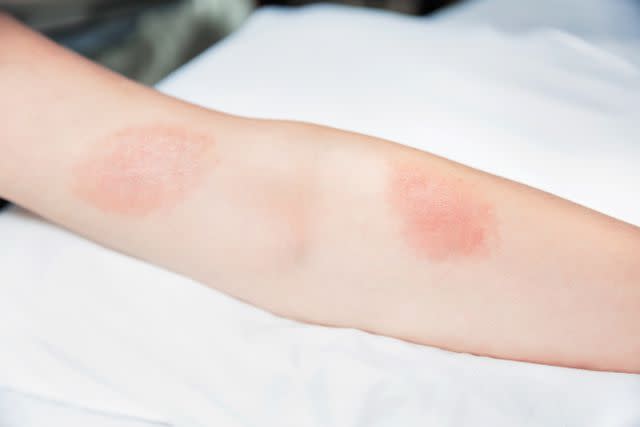
Getty Images / JodiJacobson
Poisonous plants can leave a red, extremely itchy rash with bumps or blisters on the skin. The rash often looks streaky and usually appears one to two days after your child touches the poison ivy, oak, or sumac plant. Even lightly touching a poisonous plant can cause a reaction.
Cause: An allergic reaction occurs after exposure to the oily resin in the plants' leaves. Some people are particularly sensitive to it. If the plant resin spreads on the skin after initial contact, so can the rash. So, avoid rubbing it.
Treatment: Clean the area with soapy water as soon as possible, and wash clothing to prevent spreading. Try cool baths, calamine lotion, and cool compresses to soothe the skin. Your child might need a topical corticosteroid, other topical anti-inflammatory medicine, or, in severe cases, an oral corticosteroid to control the itch and swelling.
When to Seek Help: Call your doctor if the rash involves the face or eyes, the rash gets infected, or if over-the-counter treatments aren't managing discomfort.
Molluscum
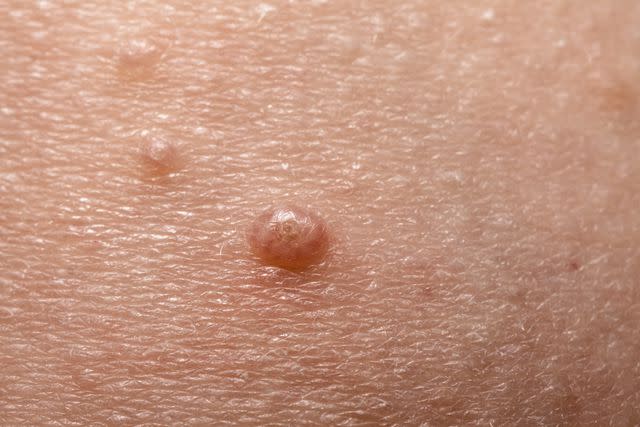
Getty Images / Lukassek
This rash has small pink, white, or flesh-colored bumps with a dimple in the center. They can become red, inflamed, and sore. You may find a molluscum rash anywhere on the body, and it often appears pearly.
Cause: Molluscum is a viral infection that's spread by skin-to-skin contact or through contaminated clothing, towels, or toys—and possibly contaminated pool water.
Treatment: It's best to avoid touching this rash, as it's quite contagious and can spread across the body. Keep the bumps covered with a bandage during the day so your child can't pick or scratch them, which can cause them to spread, says Dr. Shu. The bumps last from a few weeks to several months (but sometimes stick around for longer) and they usually go away on their own.
A dermatologist can use a variety of methods to speed things along, such as cryotherapy (freezing the lesions), laser therapy, or curettage (scrapping off the affected tissue). However, these procedures may be painful and leave a scar.
When to Seek Help: If the rash is bothersome or not going away, contact your child's doctor to explore other treatment options.
Chickenpox
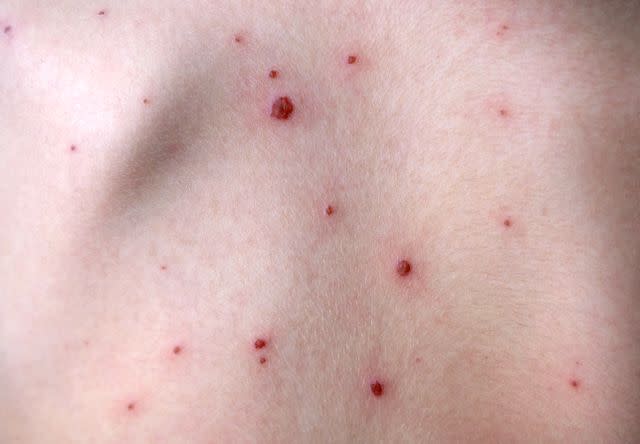
Getty Images / Photo by Alex Tihonov
Chickenpox or varicella is characterized by red spots that turn into an itchy rash of fluid-filled blisters that scab over after about a week. The rash typically shows up first on the chest, face, and back before spreading to the rest of the body. A fever usually precedes the rash.
Cause: Chickenpox is caused by the varicella-zoster virus (VZV), and it's extremely contagious. Indeed, according to the CDC, up to 90% of unvaccinated people who are exposed to the virus will get the disease. It's spread via droplets in the air or by touching the blisters (or something else that came into contact with the rash). Once the blisters have crusted, they can no longer spread chickenpox.
Treatment: The chickenpox vaccine is safe and highly effective. According to the CDC, before the vaccine, around 4 million people contracted the disease each year, with over 10,000 hospitalized. If your child gets chickenpox, it's important to keep them isolated to avoid spreading the illness.
There's no treatment for chickenpox beyond rest and taking ibuprofen or acetaminophen for fever or body aches. Avoid itching, and keep nails short to minimize irritating the skin when itching does happen. Calamine lotion and cool baking soda or oatmeal baths can help relieve itchiness.
When to Seek Help: Contact your child's doctor if they're having trouble tolerating the rash or symptoms worsen. Watch for signs of infection, which include redness and heat around the blisters.
Impetigo
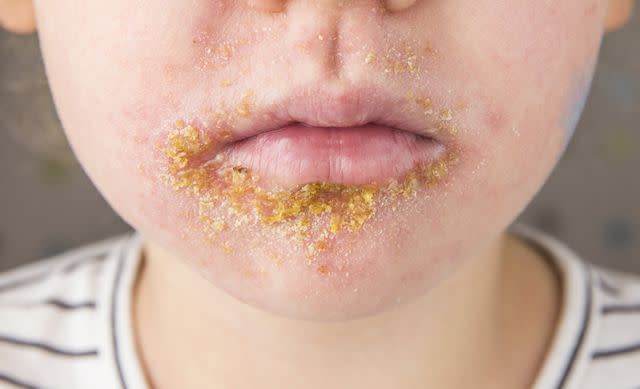
Getty Images / Helin Loik-Tomson
Impetigo is a rash of red, fragile blisters that rupture and scab over. "Classic impetigo has a honey-colored crust," says Ellen Schumann, MD, a pediatrician at the Marshfield Clinic, in Weston, Wisconsin. Although it can appear anywhere, impetigo commonly affects the areas around the nose, mouth, arms, and legs.
Cause: This rash is caused by a contagious bacterial infection that spreads through contact with infected sores or their fluids. The sores develop about 10 days after exposure.
Treatment Wash sores with antibacterial soap and water, apply a thin coat of antibiotic ointment, and cover with a bandage if possible.
When to Seek Help: See the doctor if your child might have impetigo, especially if the sores spread to other areas of the body or don't improve after a few days. They might prescribe antibiotic treatment.
Ringworm
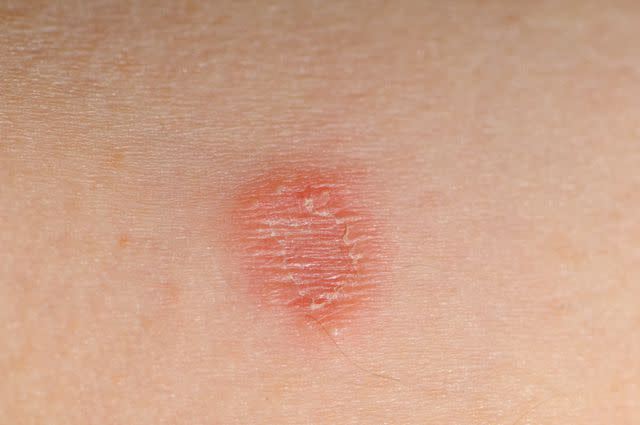
Getty Images / OGphoto
This very common skin infection gets its name from the rash's ring-shaped red marks that appear on the body. It's quite itchy and can also present as cracked, peeling, or scaly skin. When it occurs on the feet, it's often characterized by redness and itchiness between the toes and is called athlete's foot. When it's on the head, it can cause a small, scaly, red bald spot. In the groin, this rash is called jock itch.
Cause: Ringworm, which is also called tinea, is caused by a fungal infection that's spread via skin-to-skin contact or from touching an infected object, animal, or surface. Pets can carry the disease, which is one reason why regular veterinary care is so important.
Treatment: Avoid infection by washing hands regularly, wearing shower shoes in wet public environments (such as locker rooms), changing underwear and socks daily, and not sharing clothing or personal items (like towels or hairbrushes) with those infected with ringworm. Over-the-counter antifungal creams, lotions, or powders can be used to treat most infections. Follow the product directions.
When to Seek Help: Tinea infections on the scalp must be treated by a doctor as prescription medications are needed. Additionally, see a medical provider if your child's infection doesn't improve or becomes worse; they may prescribe prescription anti-fungal medication.
Swimmer's Itch
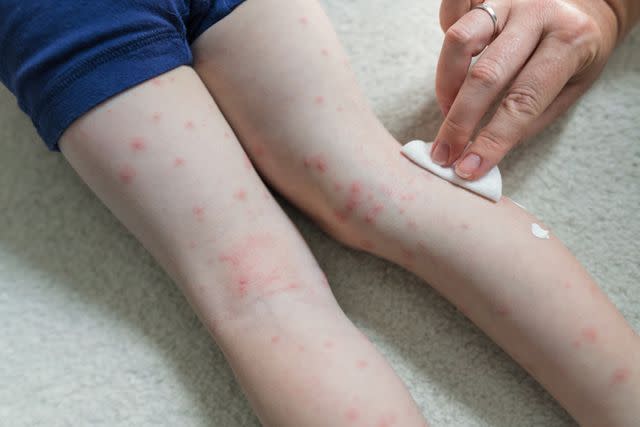
Getty Images / Petko Ninov
Swimmer's itch appears as small reddish pimples or blisters that show up after swimming. According to the CDC, the itchy, burning, or tingling rash may crop up within minutes or hours of exposure, and it can last up to a week or longer.
Cause: An allergic reaction to a microscopic parasite that's sometimes found in rivers, lakes, and oceans. Swimmer's itch is also called cercarial dermatitis. When swimmer's itch arises after being in salt water, it is known as clam-digger's itch.
Treatment: While irritating to the skin, swimmer's itch doesn't cause harm and will resolve on its own. The parasite can't live on human skin and quickly dies. Try not to itch the rash; instead, the CDC recommends treating any discomfort with baking soda paste, corticosteroid cream, cool compresses, Epsom salt baths, or colloidal oatmeal baths.
Avoid swimming in contaminated water. If the status of the water is unknown, briskly dry off your child's skin with a towel after they swim. "The friction prevents the parasite from getting into the skin," says Dr. Schumann. Note that the more frequently the skin is exposed to this allergen, the stronger the body's immune response may become, so avoid swimming in infected waters again.
When to Seek Help: Itching the rash can lead to infection. If you notice signs of infection, such as warmth, swelling, yellow or green fluid, or red streaking, contact your child's pediatrician.
For more Parents news, make sure to sign up for our newsletter!
Read the original article on Parents.

